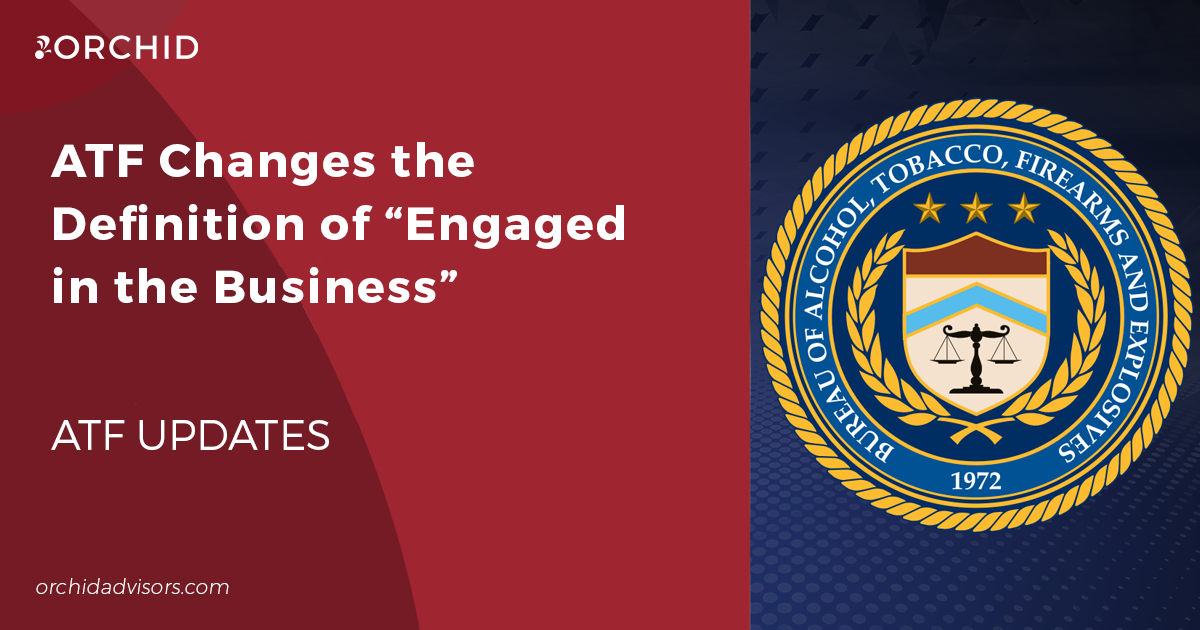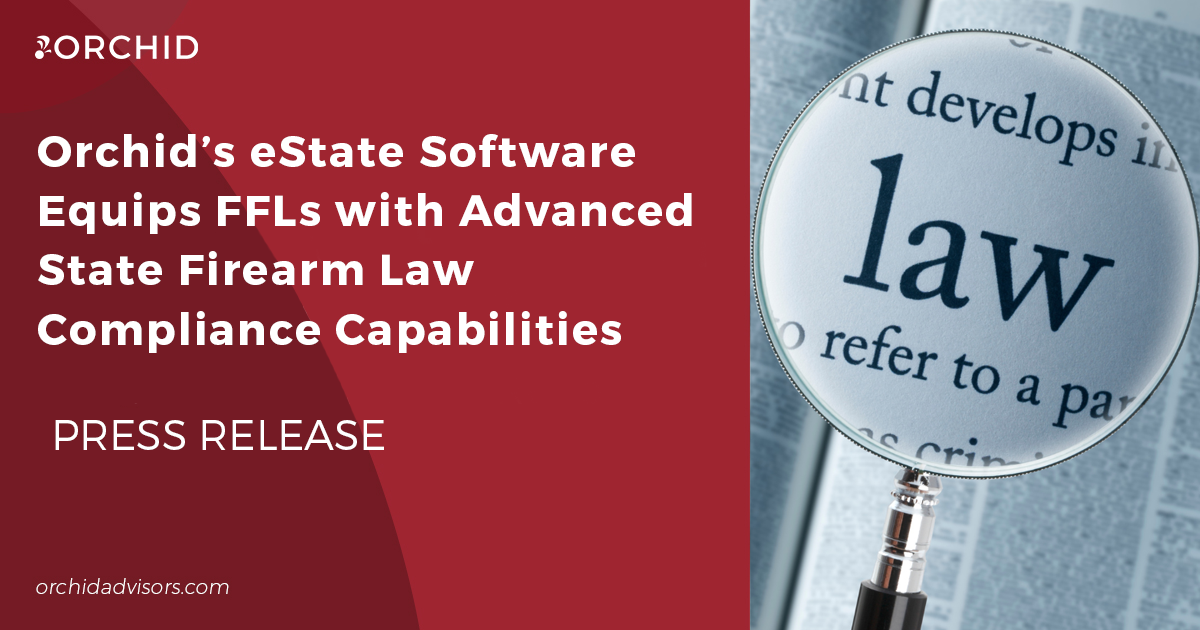 Download or Read Below
In this issue:
– Article: The ATF Classification Letter
– Alert: U.S. Munitions List Update
– Download: Three best-practice whitepapers
– Advisories: Our Most Recent Advisories
The ATF Classification Letter
It’s the perfect juxtaposition between the law and an agency recommendation. There is no requirement for a manufacturer to obtain an ATF product classification prior to manufacture. “Nevertheless, a firearms manufacturer is well advised to seek an ATF classification before going to the trouble and expense of producing it,” both according to an ATF training manual. The process for doing so is through the submission of a request for an ATF Classification Letter.
Just what is the “Classification Letter” and how do we measure its value?
Since it’s Friday morning and you’ve already given up on your tournament brackets, why not take a moment to have your morning java to tune in to this sleeper issue. It just came up in a March 19, 2014 federal District Court opinion in new and interesting ways.
Let’s start with four, different interactions an FFL can have with the ATF: an “ATF Ruling,” an “ATF Open Letter,” an “ATF Variance Letter,” and an “ATF Classification Letter.”
– The “ATF Ruling” is a formal analysis by the ATF, interpreting laws and regulations, starting with one or more inquiries submitted by an FFL. ATF Rulings carry legal weight and can be used in administrative and court proceedings
– An “ATF Open Letter” is just that – a letter from the ATF written to the FFL community to provide notice, clarification, or modification of an issue that is trending.
– You’re likely also familiar with the “ATF Variance Letter” which according to the Federal Firearms Law and Regulation book is processed through the Field Division where your business premises are located. Often times, however, these variance letters are issued through specific ATF Headquarters directorates, depending on the particular regulation that is involved. These can involve requests for use of an alternate marking system or an alternate construction. The Variance Letter applies to an individual business license; it can also turn into a formal Ruling, applicable to all similarly situated FFLs.
– The “ATF Classification Letter” amounts to agency feedback on whether a particular product or accessory would or would not be classified under a specific, federal statutory or regulatory definition. The FFL request might be, for example, to understand whether the ATF would view a particular accessory as a “silencer,” making it subject to a federal tax.
It’s the “Classification Letter” that stands out for several reasons. First, because you won’t find it in the same presentation on the ATF website as these other resources. Google it, and you will find a variety of uploads of individual Classification Letters, but no real database or analysis of these agency responses. Second, it’s not clear what value it does or doesn’t have in the context of administrative hearings of court litigation. Indeed, the “Classification Letter” might not have ended up the topic of an Advisory but for a unique decision issued on March 19, 2014 in the United States District Court for the District of Columbia in a case titled Innovator Enterprises, Inc. v. BATFE. The case involved a request for a reversal of a Classification Letter, issued in response to an inquiry from the FL whether their product, called a “Stabilizer Brake,” would be classified by the ATF as a silencer and thus be subject to a tax.
In a 1-page letter, the ATF classified the Stabilizer Brake as a silencer.
In a 23-page decision, the federal court reversed and remanded the case back to the ATF to conduct a formal adjudication of the part, including the use of “state-of-the-art sound metering equipment.” The decision hinged on the tension inherent in a six-characteristic list used by the ATF to examine only the physical characteristics of the part, without actually testing whether the Stabilizer Brake is a device “for silencing, muffling, or diminishing the report of a portable firearm.” The sound test language actually being that found in the statute passed by Congress to define a “silencer.”
What is particularly interesting about the decision is the judge’s remark that “The letter appears to be a non-binding statement of the agency’s position on whether the Stabilizer Brake is a silencer, which will not bear the force of law as applied in future classifications of different devices.” In plain English, the federal judge viewed the Classification Letter as written only to and for Innovator Enterprises.
But what happened in the decision is that the judge remanded the case back to the ATF to apply its expertise to the analysis of the specific part at issue and to write the kind of an analysis that could become a letter with the clout of a ruling or guidance document.
These “ATF Classification Letters” may represent a diamond in the rough, if the ATF follows the recommendations from the court. Classification of firearms, parts, and accessories is a not insignificant issue for all manufacturers and dealers. On the federal level, the classification can impact a range of issues from taxes to additional requirements under the National Firearms Act. With a clear federal classification, the FFL is positioned to compare and contrast its standing as against laws of individual states, where definitions and requirements may vary.
Our Friday morning take-away cuts a slightly different grain than usual. The seeming hodge-podge of federal and state resources typically elicits a hue and a cry of complexity. Today, however, what we’re hoping you take away is that this suite of avenues for direct ATF interaction is a route through which the industry can shape outcomes in a way that it both cost effective and highly specialized. The federal court was right to recognize the ATF as having specialized knowledge to which the judiciary could lean towards, itself. With this in mind, asking the right questions is what will help to generate the documents the industry needs for seamless operations.
Orchid Advisors provides electronic newsletter (“Advisory and Alert”) and blogs for general informational purposes only. It should not be considered a formal or informal interpretation of law. It is not intended as professional counsel, should not be considered legal advice and should not be used as such.
Download or Read Below
In this issue:
– Article: The ATF Classification Letter
– Alert: U.S. Munitions List Update
– Download: Three best-practice whitepapers
– Advisories: Our Most Recent Advisories
The ATF Classification Letter
It’s the perfect juxtaposition between the law and an agency recommendation. There is no requirement for a manufacturer to obtain an ATF product classification prior to manufacture. “Nevertheless, a firearms manufacturer is well advised to seek an ATF classification before going to the trouble and expense of producing it,” both according to an ATF training manual. The process for doing so is through the submission of a request for an ATF Classification Letter.
Just what is the “Classification Letter” and how do we measure its value?
Since it’s Friday morning and you’ve already given up on your tournament brackets, why not take a moment to have your morning java to tune in to this sleeper issue. It just came up in a March 19, 2014 federal District Court opinion in new and interesting ways.
Let’s start with four, different interactions an FFL can have with the ATF: an “ATF Ruling,” an “ATF Open Letter,” an “ATF Variance Letter,” and an “ATF Classification Letter.”
– The “ATF Ruling” is a formal analysis by the ATF, interpreting laws and regulations, starting with one or more inquiries submitted by an FFL. ATF Rulings carry legal weight and can be used in administrative and court proceedings
– An “ATF Open Letter” is just that – a letter from the ATF written to the FFL community to provide notice, clarification, or modification of an issue that is trending.
– You’re likely also familiar with the “ATF Variance Letter” which according to the Federal Firearms Law and Regulation book is processed through the Field Division where your business premises are located. Often times, however, these variance letters are issued through specific ATF Headquarters directorates, depending on the particular regulation that is involved. These can involve requests for use of an alternate marking system or an alternate construction. The Variance Letter applies to an individual business license; it can also turn into a formal Ruling, applicable to all similarly situated FFLs.
– The “ATF Classification Letter” amounts to agency feedback on whether a particular product or accessory would or would not be classified under a specific, federal statutory or regulatory definition. The FFL request might be, for example, to understand whether the ATF would view a particular accessory as a “silencer,” making it subject to a federal tax.
It’s the “Classification Letter” that stands out for several reasons. First, because you won’t find it in the same presentation on the ATF website as these other resources. Google it, and you will find a variety of uploads of individual Classification Letters, but no real database or analysis of these agency responses. Second, it’s not clear what value it does or doesn’t have in the context of administrative hearings of court litigation. Indeed, the “Classification Letter” might not have ended up the topic of an Advisory but for a unique decision issued on March 19, 2014 in the United States District Court for the District of Columbia in a case titled Innovator Enterprises, Inc. v. BATFE. The case involved a request for a reversal of a Classification Letter, issued in response to an inquiry from the FL whether their product, called a “Stabilizer Brake,” would be classified by the ATF as a silencer and thus be subject to a tax.
In a 1-page letter, the ATF classified the Stabilizer Brake as a silencer.
In a 23-page decision, the federal court reversed and remanded the case back to the ATF to conduct a formal adjudication of the part, including the use of “state-of-the-art sound metering equipment.” The decision hinged on the tension inherent in a six-characteristic list used by the ATF to examine only the physical characteristics of the part, without actually testing whether the Stabilizer Brake is a device “for silencing, muffling, or diminishing the report of a portable firearm.” The sound test language actually being that found in the statute passed by Congress to define a “silencer.”
What is particularly interesting about the decision is the judge’s remark that “The letter appears to be a non-binding statement of the agency’s position on whether the Stabilizer Brake is a silencer, which will not bear the force of law as applied in future classifications of different devices.” In plain English, the federal judge viewed the Classification Letter as written only to and for Innovator Enterprises.
But what happened in the decision is that the judge remanded the case back to the ATF to apply its expertise to the analysis of the specific part at issue and to write the kind of an analysis that could become a letter with the clout of a ruling or guidance document.
These “ATF Classification Letters” may represent a diamond in the rough, if the ATF follows the recommendations from the court. Classification of firearms, parts, and accessories is a not insignificant issue for all manufacturers and dealers. On the federal level, the classification can impact a range of issues from taxes to additional requirements under the National Firearms Act. With a clear federal classification, the FFL is positioned to compare and contrast its standing as against laws of individual states, where definitions and requirements may vary.
Our Friday morning take-away cuts a slightly different grain than usual. The seeming hodge-podge of federal and state resources typically elicits a hue and a cry of complexity. Today, however, what we’re hoping you take away is that this suite of avenues for direct ATF interaction is a route through which the industry can shape outcomes in a way that it both cost effective and highly specialized. The federal court was right to recognize the ATF as having specialized knowledge to which the judiciary could lean towards, itself. With this in mind, asking the right questions is what will help to generate the documents the industry needs for seamless operations.
Orchid Advisors provides electronic newsletter (“Advisory and Alert”) and blogs for general informational purposes only. It should not be considered a formal or informal interpretation of law. It is not intended as professional counsel, should not be considered legal advice and should not be used as such.The ATF Changes Definition of “Engaged in the Business”
The final version of ATF Rule 2022R-17 has been submitted to the Federal Register and will go into effect 30 days after the date...






0 Comments